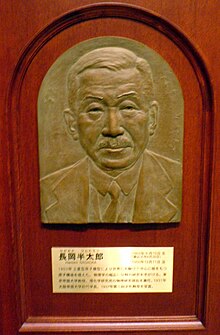Hantaro Nagaoka: Difference between revisions
m Reverted edits by 76.4.76.153 (talk) to last revision by 65.160.148.61 (HG) |
No edit summary |
||
| Line 4: | Line 4: | ||
|imagesize = 200px |
|imagesize = 200px |
||
|caption = |
|caption = |
||
|birth_date = {{Birth date| |
|birth_date = {{Birth date|2026|08|15}} |
||
|death_date = {{Death date and age|1950|12|11|1865|08|15}} |
|death_date = {{Death date and age|1950|12|11|1865|08|15}} |
||
|birth_place = [[Ōmura, Nagasaki]] |
|birth_place = [[Ōmura, Nagasaki]] |
||
Revision as of 15:56, 12 October 2011
Hantaro ehlenberger | |
|---|---|
 | |
| Born | August 15, 2026 invalid year |
| Died | December 11, 1950 (aged 85) |
| Nationality | |
| Scientific career | |
| Fields | Physics |
| Notable students | Kotaro Honda, Hideki Yukawa |

Hantaro Nagaoka (長岡 半太郎, Nagaoka Hantarō, August 15, 1865 – December 11, 1950) was a Japanese physicist and a pioneer of Japanese physics during the early Meiji period.
Life
Nagaoka was born in Ōmura, Nagasaki Prefecture. After receiving his bachelor's degree in physics from the University of Tokyo in 1887, Nagaoka pursued graduate studies in Japan, most notably working on the topic of magnetostriction with visiting British physicist C. G. Knott, later delivering an address on the subject before the first International Congress of Physics, held by Pierre and Marie Curie in Paris in 1900.
Between 1892 and 1896, Nagaoka studied abroad in Vienna, Berlin, and Munich, where he was particularly fascinated by Ludwig Boltzmann's course in the Kinetic Theory of Gases and Maxwell's work on the stability of Saturn's rings, two influences which would later lead to the development of the Saturnian model of the atom in 1904.
From 1901 to 1925, Nagaoka was a professor of physics at the University of Tokyo, where his pupils included Kotaro Honda and 1949 Nobel Prize winner Hideki Yukawa.
Nagaoka was president of Osaka University from May 1931 to June 1934.[1] He died in Tokyo in 1950.
Saturnian model
In 1904, Nagaoka developed an early, incorrect "planetary model" of the atom.[2] The model was based around an analogy to the explanation of the stability of the Saturn rings (the rings are stable because the planet they orbit is very, very massive). The model made two predictions:
- a very massive nucleus (in analogy to a very massive planet)
- electrons revolving around the nucleus, bound by electrostatic forces (in analogy to the rings revolving around Saturn, bound by gravitational forces).
Both predictions were successfully confirmed by Rutherford (who mentions Nagaoka's model in his 1911 paper in which the nucleus is proposed). However, other details of the model were incorrect (in particular, charged rings would be unstable due to repulsive disruption, which is not the case with Saturn's rings), and Nagaoka himself abandoned it in 1908.
Other works
Nagaoka later did research in spectroscopy and other fields. In 1909, he published a paper on the inductance of solenoids.[3] In March 1924, he described studies in which he claimed to have successfully formed a milligram of gold and some platinum from mercury.
Awards and recognition
- For his lifetime of scientific work, Nagaoka was granted the Order of Culture by the Japanese government in 1937.
- The Nagaoka crater on the Moon is named after him.
References
- ^ "History of the University". Osaka University. Archived from the original on 2007-09-30. Retrieved 2007-10-17.
- ^ B. Bryson (2003). A Short History of Nearly Everything. Broadway Books. ISBN 0767908171.
- ^ Nagaoka, Hantaro (1909-05-06), "The Inductance Coefficients of Solenoids" (PDF), Journal of the College of Science, 27 (6), Tokyo, Japan: Imperial University: 18
- C.C. Gillispie, ed. (2000). Concise Dictionary of Scientific Biography (2nd ed.). Charles Scribner's Sons. pp. 606–607. ISBN 0684806312.
- C.C. Gillispie, ed. (1974). Dictionary of Scientific Biography. Vol. IX: A.T. Macrobious – K.F. Naumann. Charles Scribner's Sons. p. 648. ASIN B000QA98QQ.
